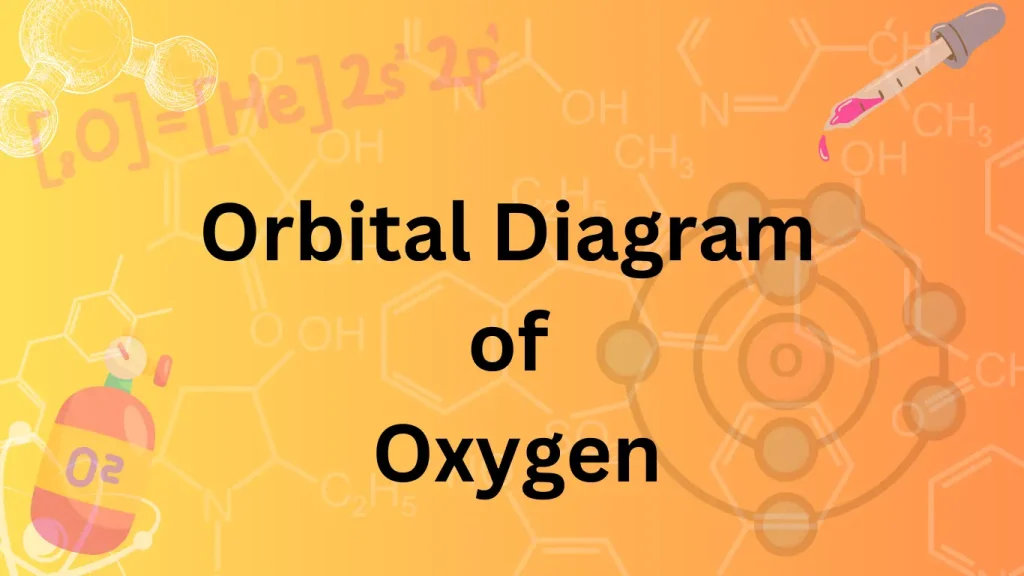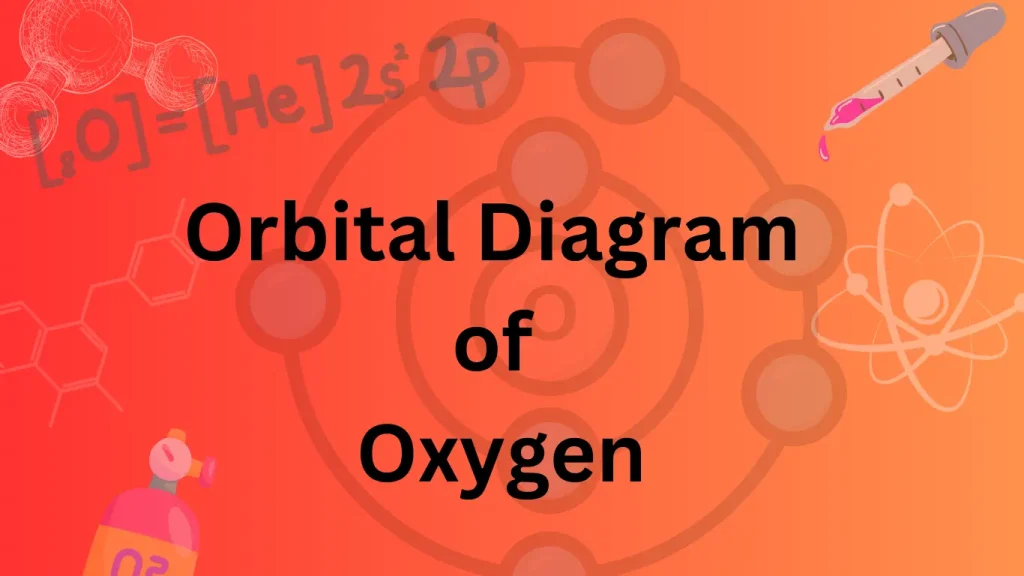The orbital diagram of oxygen shows its electron configuration as 1s² 2s² 2p⁴. Oxygen has eight electrons distributed in different energy levels.
Oxygen, a vital element for life, has an atomic number of eight. The electron configuration of oxygen can be represented through an orbital diagram, which visually represents the distribution of electrons in various orbitals. In the case of oxygen, the first two electrons occupy the 1s orbital, the next two fill the 2s orbital, and the remaining four electrons are distributed in the 2p orbitals.
Understanding the orbital diagram helps comprehend oxygen’s chemical bonding and reactivity, which is crucial in fields like chemistry and biochemistry. This foundational knowledge is essential for students and professionals alike. Oxygen Electron Configuration

Introduction To Atomic Orbitals
Atoms are the building blocks of matter. Each atom has a nucleus and electrons. The nucleus contains protons and neutrons. Electrons move around the nucleus in regions called orbitals. Orbitals are areas where electrons are likely to be found. Each orbital can hold a maximum of two electrons.
Orbitals help us understand how atoms bond. They show where electrons are likely to be. This helps in predicting chemical reactions. Knowing the orbital arrangement is crucial in chemistry. Oxygen’s orbital diagram shows how its electrons are arranged. This makes it easier to understand its chemical properties.
Electron Configuration Of Oxygen
Oxygen has 8 electrons. Electrons fill energy levels based on specific rules. The first 2 electrons fill the 1s orbital. The next 2 electrons fill the 2s orbital. The remaining 4 electrons fill the 2p orbitals. Electrons fill orbitals in a specific order. This order is based on energy levels. Lower energy levels fill first. Higher energy levels fill last.
The Pauli Exclusion Principle is important. It states that no two electrons can have the same set of quantum numbers. This means each electron in an atom has a unique position. Electrons with the same spin stay apart. This principle helps explain the structure of atoms. It also helps understand electron arrangements.
Orbital Notation
Oxygen has eight electrons. These electrons fill up different orbitals. The orbitals are shown as boxes. Each box can hold two electrons. In the orbital notation, each electron is represented by an arrow. The arrows can point up or down. This shows the direction of the electron’s spin. The first two electrons fill the 1s orbital. The next two fill the 2s orbital. The last four fill the 2p orbitals. Here is the orbital diagram for oxygen:
| 1s | ↑↓ |
| 2s | ↑↓ |
| 2p | ↑↓↑↑ |
Electrons have a property called spin. Spin can be up or down. In an orbital, two electrons must have opposite spins. This means one arrow points up and one arrow points down. This helps to fill the orbitals correctly. The spin of electrons affects how they interact. Opposite spins help to keep electrons in place.
Hund’s Rule
Hund’s Rule helps us fill orbitals correctly. It says to maximize unpaired electrons first, which makes atoms more stable. Electrons prefer to be alone in an orbital, so we put one electron in each orbital before pairing them. This way, the atom reaches a lower energy state.
Electrons follow energy rules. Low-energy orbitals are filled before high-energy ones. The 2p orbitals are higher in energy for oxygen than the 2s orbitals. Electrons fill the 2s orbital first, then move to the 2p orbitals. This keeps the atom stable and balanced.
Drawing The Orbital Diagram
Start with the 1s orbital. Place two electrons in the 1s orbital. Next, fill the 2s orbital with two electrons. Then, move to the 2p orbitals. Oxygen has six electrons in the second shell. The 2p orbitals can hold six electrons in total. Fill each 2p orbital with one electron first. This follows Hund’s rule. After each 2p orbital has one electron, add the remaining electrons. Two 2p orbitals will have two electrons each. The last 2p orbital will have one electron.
Many forget Hund’s rule. Always fill each 2p orbital with one electron first. Another mistake is adding electrons to 3s before finishing 2p. Remember, 2p comes before 3s.
Molecular Orbital Theory
Bonding orbitals are lower in energy. Electrons in these orbitals help hold the atoms together. Antibonding orbitals are higher in energy. Electrons in these orbitals can weaken or break bonds. Both types of orbitals are important for understanding molecules.
Oxygen has 8 electrons in total. Four electrons fill the bonding orbitals. The other four fill the antibonding orbitals. This makes oxygen a stable molecule. Bonding orbitals make oxygen stronger. Antibonding orbitals do not make it weak enough to break.
Applications Of Orbital Diagrams
Orbital diagrams help understand chemical bonding. They show how electrons are arranged in an atom, helping predict how atoms will bond. For example, oxygen has six valence electrons. The orbital diagram shows two electrons in the 2s orbital and four in the 2p orbital. This arrangement explains why oxygen forms two bonds in molecules like H2O.
Orbital diagrams can predict molecular properties. They show the arrangement of electrons, which helps in understanding the reactivity of molecules. For example, the orbital diagram of oxygen shows that it has unpaired electrons. These unpaired electrons make oxygen a reactive molecule. This explains why oxygen supports combustion and is essential for life.
Advanced Concepts
Hybridization involves mixing atomic orbitals. It creates new hybrid orbitals. These orbitals help explain molecule shapes. For oxygen, hybridization is important. It helps understand bonding. Oxygen uses sp2 and sp3 hybridization. This depends on the molecules it forms. In O2, oxygen does not hybridize. Water (H2O) uses sp3 hybridization. This gives water its bent shape.
Excited states occur when electrons gain energy and move to higher orbitals. In oxygen, electrons can get excited. This happens under specific conditions. Excited states are temporary. Electrons return to the ground state quickly. Excited states affect chemical reactions. They can release energy as light, which is called fluorescence. Understanding excited states is key. It explains many chemical behaviors. Learn more about Oxygen Electron Configuration in the main guide. Google Maps
Frequently Asked Questions
What Is The Orbital Diagram Of Oxygen?
The oxygen orbital diagram shows the arrangement of electrons in atomic orbitals. Oxygen has 8 electrons, and its configuration is 1s² 2s² 2p⁴.
How Many Electrons Does Oxygen Have?
Oxygen has a total of 8 electrons. These electrons are distributed in their atomic orbitals: 1s² 2s² 2p⁴.
What Is The Electron Configuration Of Oxygen?
Oxygen’s electron configuration is 1s² 2s² 2p⁴, which shows the distribution of electrons in oxygen’s atomic orbitals.
Why Is The Orbital Diagram Important?
The orbital diagram helps us understand the distribution of electrons. It is crucial for predicting chemical behavior and bonding.
Conclusion
Understanding the orbital diagram of oxygen is crucial for chemistry enthusiasts. It provides insights into electron arrangements and reactivity. By mastering this concept, you can better grasp chemical bonding and molecular structures. Keep exploring and practicing to deepen your knowledge in this fascinating field.
